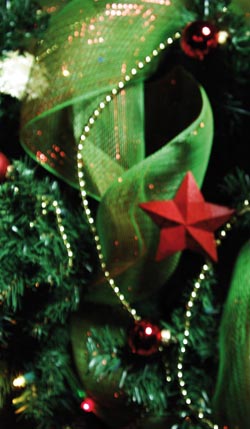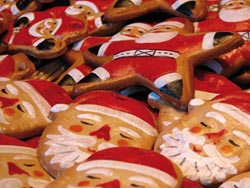"The long Christmas dinner" continues. When Thornton
Wilder wrote it, in 1931, giving his play script a symbolic charge on
the meaning of time and life (contained and represented in the
ritualization and repetitiveness of traditions), he probably thought that
these rituals and traditions centered on the Christmas Holidays could not
ever change or at least not disappear completely.
In reality, even if
"Christmas dinner" is renewed each year, the ways and the accessories have
changed a lot over time if not disappeared. The conjunction of cultures
and customs, consumerism, faltering values, we have given it today more of
a business role however festive, than the time of intimism and
contemplation it was.
There remains the fact, nevertheless, that the
Christmas Holidays continue to be celebrated in joy and hope practically
all over the world and, even in the diversity of symbols, rituals and
gastronomic specialities that the various nations prepare for that
particular time of the year, what is common to everyone is the pleasure to
celebrate around special meals and the joy to exchange good wishes. There
are also "signs" that characterize the solemnity of the end of the year:
the bread, the fire (we think of the Yule logs found in many regions not
only in Italy; to the "ndocce" of Agnone in the Molise (major flares
composed of a wooden fir with dried gorse burning evolve into a strong
light); the lights (represented by abundant decorative candles lit
everywhere during the season); the bred, that can be associated to recipes
that in many cultures peoples hand down for the meals of these days.
In
Medieval times, in Europe, people prepared a round bread, to be reminded
of the sun, with at its centre a cross that recalled Christianity and the
four seasons of the year, fixed periods for folk life; in England, they
made a special cake filled with spices to be reminded of the gifts of the
Three Kings; in Provence, still today, the bakers at Christmas offer bread
with saffron or anise and right here in Bologna, special bread, certosino
(a liquor similar to chartreuse) and the more modest "panone" are prepared
and consumed during the Holidays. In an hypothetic travel in the Holiday
gastronomy (Christmas or New Year's dinner), we will remember: chickpea
soup, macaroni with nuts, dried cod, eel and celery, for New Year's Eve in
Marche; in Calabria, at Diamante, the "chinoli" (sweets prepared for
Christmas dinner on December 24th, are made with
puff pastry soaked in white wine and filled with nuts, chestnuts, cacao
and a few drops of coffee, everything is then fried and covered with
honey; and for the meal the tradition there has to be 13 different
courses; in Cosenza or in Sila seasoned spaghetti with grated bread and
anchovies, first fried in oil (the so-called pasta and mullica) and the
sweets: "turdilli", "scalille" and "pittulille" (deep fried sweets with
peanuts, nutmet, cinnamon, Marsala, apples, etc.). In lower Ferrarese, on
New Year's evening, the menu is composed of fish, most of all eels, and
the table was prepared (during the night) with the most beautiful
tablecloth on which was placed sweet-smelling bread, a glass of water and
a glass of red wine for Jesus' first meal; while in the fireplace a large
Yule log was placed which could stay lit all night so that baby Jesus
could warm up immediately.
The custom of leaving water on the
dressed-up table, as well as bread and a bit of butter to feed baby Jesus
is common also in other areas, namely Reggiano. In Teramano, for Christmas
lunch, the "cardone in brodo" (broth with meatballs) is prepared, as well
as "maccheroni alla chitarra" (spaghetti-like pasta that is square in
cross section with meatballs) and "caggionetti" (fried sweets, with
chestnuts, honey and rum).
Elsewhere we find: in Greece, a cake called
Vassilopitta; in Ireland, the apple sauce with S. Michael's goose, duck or
turkey; in the West Indies, there is glazed Creole prosciutto; in the USA,
stuffed turkey; in Germany, Stollen (Christmas bread) and small sweets
with cinnamon, spiced bread and caramelized sugar.
On tables in Bologna
“the Fat Town" for many generations has learned a triad of meals:
tortellini, swallow-fish, certosino and a sweet originating from the
country: the pinza, ring-shaped pasta rolled up around a filling of pine
forests (apple quince and other fruits, reduced to two-thirds from
boiling) decorated on top by tiny little balls made of coloured sugar
called "bilen".
Little by little, culinary traditions, more or less
close to us, arrived: the "zampone" (pig's trotter stuffed with seasoned
mincemeat) with lentils ("which bring in the money”); the Anglo-Saxon
sweet and spiced pudding in which is hidden a coin which will bring
fortune to the person will find it in his portion; the "panettone" from
Milan. Now that the table is laid out and that there are recipes for
everyone's taste, the last thing we need to do is wish you a Very Merry
Christmas and an Wonderful New Year!

